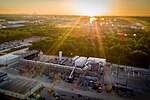La Porte High School (Texas)
La Porte High School is a High school based in La Porte, Texas, United States. It is part of the La Porte Independent School District. The school serves the cities of La Porte, Morgan's Point, and Shoreacres, as well as a small portion of Pasadena and of Deer Park.After 1946 the school moved into a new campus built on the same location, until 1959 when it relocated into a new campus built nearby. Over the years the campus has had many additions, such as E building, first built in 1968, and B building, built in 1986. Both buildings contained additional classrooms. The campus added a vocational wing, a new basketball gymnasium, swimming pool, and the Sonja Angelo Theater in 1976. In the early 1990s the school added a science wing, a new field house, and the Henry Eienfelt Band Hall. A bond referendum approved major renovations for the campus, including a major renovation of the Sonja Angelo Theater, demolition and replacement of the old gymnasium built in 1958, major renovations to the deteriorating cafeteria, and major renovations to the football and baseball stadiums.
Excerpt from the Wikipedia article La Porte High School (Texas) (License: CC BY-SA 3.0, Authors).La Porte High School (Texas)
South Iowa Avenue,
Geographical coordinates (GPS) Address External links Nearby Places Show on map
Geographical coordinates (GPS)
| Latitude | Longitude |
|---|---|
| N 29.653611111111 ° | E -95.014166666667 ° |
Address
La Porte High School
South Iowa Avenue
77571
Texas, United States
Open on Google Maps







